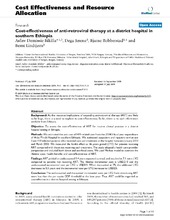Cost-effectiveness of anti-retroviral therapy at a district hospital in southern Ethiopia
Peer reviewed, Journal article
Published version
Permanent lenke
https://hdl.handle.net/1956/7278Utgivelsesdato
2009-07-17Metadata
Vis full innførselSamlinger
Originalversjon
https://doi.org/10.1186/1478-7547-7-13Sammendrag
Background: As the resource implications of expanding anti-retroviral therapy (ART) are likely to be large, there is a need to explore its cost-effectiveness. So far, there is no such information available from Ethiopia. Objective: To assess the cost-effectiveness of ART for routine clinical practice in a district hospital setting in Ethiopia. Methods: We estimated the unit cost of HIV-related care from the 2004/5 fiscal year expenditure of Arba Minch Hospital in southern Ethiopia. We estimated outpatient and inpatient service use from HIV-infected patients who received care and treatment at the hospital between January 2003 and March 2006. We measured the health effect as life years gained (LYG) for patients receiving ART compared with those not receiving such treatment. The study adopted a health care provider perspective and included both direct and overhead costs. We used Markov model to estimate the lifetime costs, health benefits and cost-effectiveness of ART. Findings: ART yielded an undiscounted 9.4 years expected survival, and resulted in 7.1 extra LYG compared to patients not receiving ART. The lifetime incremental cost is US$2,215 and the undiscounted incremental cost per LYG is US$314. When discounted at 3%, the additional LYG decreases to 5.5 years and the incremental cost per LYG increases to US$325. Conclusion: The undiscounted and discounted incremental costs per LYG from introducing ART were less than the per capita GDP threshold at the base year. Thus, ART could be regarded as cost-effective in a district hospital setting in Ethiopia.
Utgiver
BioMed CentralTidsskrift
Cost Effectiveness and Resource AllocationOpphavsrett
Asfaw Bikilla et al.; licensee BioMed Central Ltd.Copyright 2009 Bikilla et al; licensee BioMed Central Ltd.

